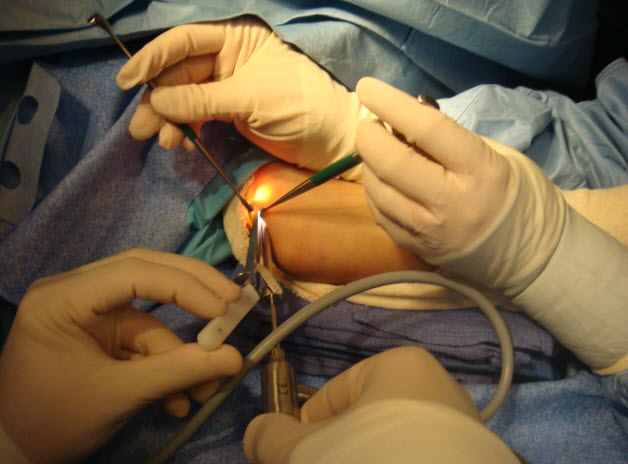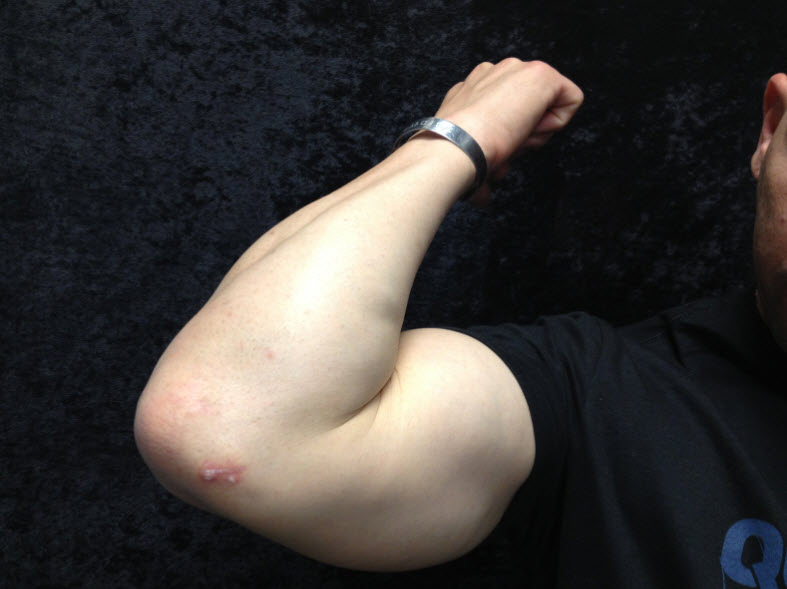“CTS, ONLY ONE SURGEON IN SOUTH FLORIDA TO PERFORM ENDOSCOPIC CUBITAL TUNNEL RELEASE PROCEDURE”
Miami March 1st, 2013– What is Cubital Tunnel Syndrome? Cubital Tunnel Syndrome is a condition brought on by increased
pressure on the ulnar nerve at the elbow. There is a bump (made of bone) on the inner portion of the elbow (the medial epicondyle) under which the ulnar nerve passes. This site is commonly called the “funny bone”. It is here that the ulnar nerve lies directly next to the bone and is susceptible to pressure. When the pressure on the nerve becomes great enough to disturb the way the nerve works, then numbness, tingling, and pain may be felt in the elbow, forearm, hand, and/or fingers.
Symptoms Cubital tunnel syndrome symptoms usually include pain, numbness, and/or tingling. The numbness or tingling most often occurs in the ring and little fingers. The symptoms are usually felt when there is pressure on the nerve, such as sitting with the elbow on an armrest, or with repetitive elbow bending and straightening. Often symptoms will be felt when the elbow is held in a bent position for a period of time, such as when holding the phone, or while sleeping.
Some patients may notice weakness while pinching, occasional clumsiness, and/or a tendency to drop things. In severe cases, sensation may be lost and the muscles in the hand may lose bulk and strength. Treatment without Surgery Symptoms may sometimes be relieved without surgery, particularly if the EMG/NCS testing shows that the pressure on the nerve is minimal. Changing the patterns of elbow use may significantly reduce the pressure on the nerve.
Avoiding putting your elbow on hard surfaces may help, or wearing an elbow pad over the ulnar nerve and “funny bone” may help. Keeping the elbow straight at night with a splint also may help. A session with a therapist to learn ways to avoid pressure on the nerve may be needed. New Minimally Invasive Procedure Available Comparative Procedures Endoscopic Cubital Tunnel Release. The innovative, newer endoscopic method performed by the American Hand Institute surgeons does not require a large incision or lengthy recovery time. This procedure, which the surgeons at the American Hand Institute perform, is less invasive, less painful and typically allows for faster recovery. - “It is very important that patients know about this new alternative to treat the Cubital Tunnel Syndrome.
Through a tiny incision a faster procedure can be done with less stress for the patient and less recovery time than the traditional surgery for this health condition. My patients have experienced an immediate disappearance of CTS symptoms after this procedure.”- Affirms Dr Alejandro Badia, world-renowned upper limb surgeon, who is now in India and has been in Jordan, Aman and Dubai, teaching colleagues this and other innovative new minimally invasive surgical procedures.
Open Cubital Tunnel Release. Many surgeons will recommend shifting the nerve to the front of the elbow, which relieves pressure and tension on the nerve. The nerve may be placed under a layer of fat, under the muscle, or within the muscle. Some surgeons may recommend trimming the bony bump (medial epicondyle). Following surgery, the recovery will depend on the type of surgery that was performed. Restrictions on lifting and/or elbow movement may be recommended. Therapy may be necessary.
According to the American Hand Institute only a few surgeons in the country offer this particular procedure. Dr. Alejandro Badia is the only one to offer it in South Florida. Alejandro Badia, MD, FACS is a hand and upper extremity surgeon. He studied physiology at Cornell University and obtained his medical degree at NYU, where he also trained in orthopedics. A hand fellowship at Alleghany General Hospital in Pittsburgh was followed by an AO trauma fellowship in Freiburg, Germany. He runs an active international hand fellowship, serves on the editorial board of two hand journals, and organizes a yearly Miami meeting for surgeons and therapists that are devoted to upper limb arthroscopy and arthroplasty (www.miamihandcourse.com).
This international meeting is held at the world-renowned Miami Anatomical Research Center (M.A.R.C.), the world’s largest surgical cadaveric training lab that Dr. Badia co-founded in 2005. In 2008, he completed the Badia Hand to Shoulder Center, a fully integrated clinical facility for the upper limb encompassing digital radiography, MRI extremity imaging, Integra rehabilitation facility and the Surgery Center at Doral. More recently, Dr. Badia inaugurated OrthoNOW, the first immediate orthopedic care center in South Florida which is staffed by surgeons from the International Orthopedic Group (IOG), a group of surgeons from lower extremity, upper limb and spine subspecialties who also treat elective orthopedic problems in international patients.
He is member of the ASSH, AAHS, AAOS as well as honorary member of many foreign hand surgery societies and President of ISSPORTH.

CTS- Minimally Invasive Procedure

Endoscopic Cubital Tunnel Release Scar

Dr Badia with Anatomy Paintings

Dr. Badia in Scrubs





